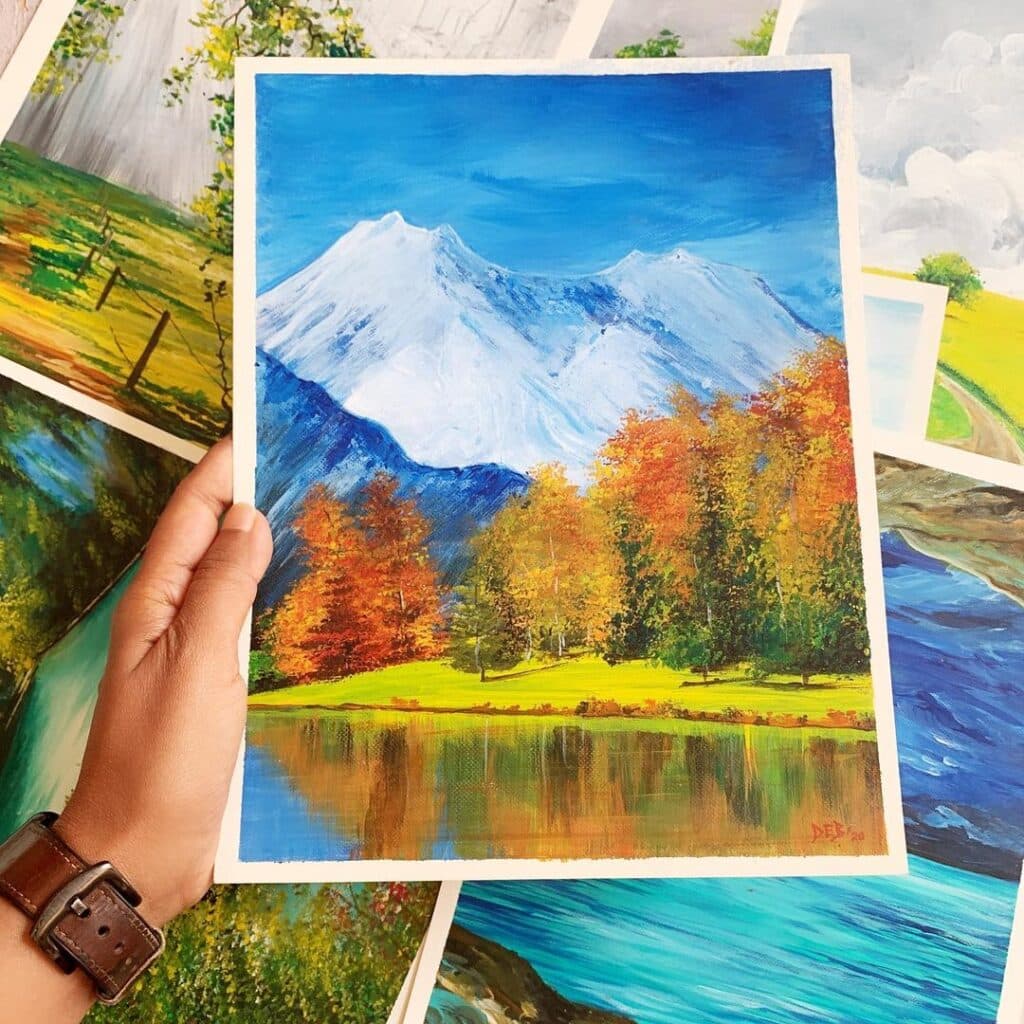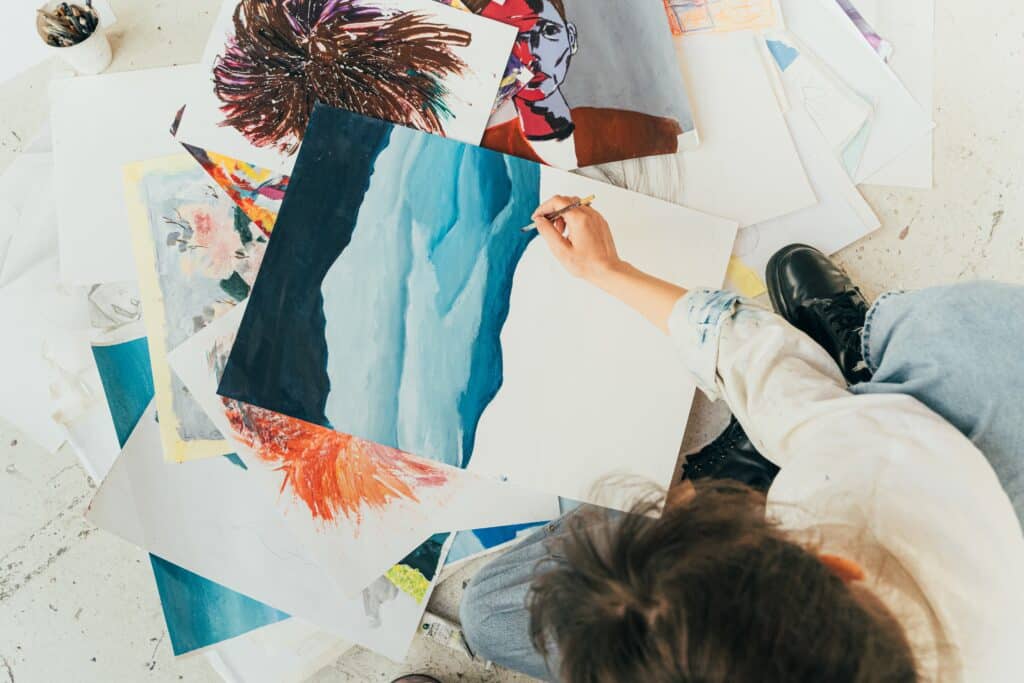Are you ready to embark on a journey of artistic discovery through the breathtaking beauty of landscapes?
In this article, we’ll explore a variety of inspiring acrylic landscape painting projects perfect for beginners.
Whether you’re brand new to painting or looking to expand your skills, these projects are sure to ignite your creativity and bring the wonders of nature to life on canvas.
Getting Started with Acrylics
Before we dive into the projects, let’s take a moment to familiarize ourselves with acrylic paints. Acrylics are known for their versatility and quick drying time, making them ideal for capturing the vibrant colors and textures of landscapes.
1. Acrylic Paints
Think of acrylic paints as your magical potions. They dry quickly, allowing you to layer colors and experiment. Start with a basic set of primary colors and gradually expand your collection. Remember, a little paint goes a long way!
2. Paintbrushes
Your brushes are like wands—each with its own spell. Here are some tips:
- Brush Shapes: Invest in a variety of shapes—flat, round, and pointed round. Larger brushes cover backgrounds, medium-sized ones work for shapes and objects, and tiny brushes handle details.
- Synthetic Bristles: Beginners often prefer synthetic brushes because they hold up well to acrylics and are budget-friendly.
3. Palette and Canvas
The palette is your mixing playground. Choose a wet palette to keep your paints moist. As for the canvas, it’s your portal to another world. Canvases come in various shapes and sizes. If you’re planning on trying out several of the ideas below, consider purchasing a multi-pack.
4. Masking Tape and More
Masking tape is your artistically. Use it to create crisp edges or block off sections for color blocking projects. Keep a cup of water nearby to rinse your brushes when switching colors, and have some rag or paper towels handy for drying them.
Project 1: Vibrant Forest Scene
Let’s kick things off with a vibrant forest scene. Start by sketching out the basic shapes of trees and foliage on your canvas using a pencil. Then, using a combination of bold brush strokes and rich greens and browns, bring your forest to life. Play with light and shadow to create depth and dimension in your painting.
Tips for Success
- Use a variety of brush sizes and shapes to create different textures in your forest.
- Experiment with layering and glazing techniques to add depth to your painting.
- Don’t worry about getting every detail perfect – the beauty of a forest lies in its organic, imperfect shapes.
Project 2: Serene Seaside Sunset
Next up, let’s capture the serene beauty of a seaside sunset. Start by sketching out the basic shapes of the ocean, mountains, and trees on your canvas. Then, using a warm color palette of oranges, pinks, and purples, paint the sky and water, blending the colors together to create a soft, ethereal effect. Add silhouettes of trees and mountains in the foreground to complete the scene.
Tips for Success
- Start with a light wash of color for the sky and water, then gradually build up layers of paint to create depth and richness.
- Use a dry brush technique to create the illusion of texture in the water and clouds.
- Don’t be afraid to experiment with different color combinations and brush strokes to capture the beauty of the sunset.
Project 3: Majestic Mountain Landscape
For our third project, let’s tackle a majestic mountain landscape. Start by sketching out the basic shapes of the mountains on your canvas using a pencil. Then, using a combination of cool blues and purples for the shadows and warm browns and greens for the highlights, paint the mountains, paying attention to the play of light and shadow on the slopes. Add details such as trees, rocks, and clouds to complete the scene.
Tips for Success
- Use a variety of brush strokes and techniques to create texture and depth in the mountains.
- Pay attention to the direction of light in your painting and use highlights and shadows to create a sense of volume and form.
- Don’t worry about getting every detail perfect – the beauty of a mountain landscape lies in its rugged, untamed nature.
Project 4: Peaceful Countryside Farm
In our fourth project, let’s explore the tranquil beauty of a countryside farm. Start by sketching out the basic shapes of the farmhouse, barn, and fields on your canvas using a pencil. Then, using a soft color palette of greens, yellows, and browns, paint the fields and trees, adding details such as fences, animals, and crops to bring the scene to life.
Tips for Success
- Use a variety of brush sizes and strokes to create depth and dimension in your painting.
- Pay attention to perspective and scale when painting objects in the distance versus those in the foreground.
- Don’t be afraid to add small details and embellishments to make your countryside farm scene come alive.
Project 5: Coastal Seascape
For our fifth project, let’s capture the beauty of a coastal seascape. Start by sketching out the basic shapes of the ocean, cliffs, and shoreline on your canvas using a pencil. Then, using a cool color palette of blues and greens, paint the ocean and sky, adding highlights and shadows to create movement and depth. Add details such as crashing waves, seafoam, and rocks to complete the scene.
Tips for Success
- Experiment with different brush strokes and techniques to create the illusion of movement in the water.
- Pay attention to the horizon line and use it as a reference point for creating a sense of perspective in your seascape.
- Don’t be afraid to add small details such as seagulls, boats, or beachgoers to add interest to your painting.
Project 6: Enchanting Forest Path
In our sixth and final project, let’s take a stroll down an enchanting forest path. Start by sketching out the basic shapes of the trees, foliage, and path on your canvas using a pencil. Then, using a warm color palette of greens, browns, and yellows, paint the foliage and path, adding highlights and shadows to create depth and texture. Add details such as sunlight filtering through the trees, fallen leaves, and moss-covered rocks to complete the scene.
Tips for Success
- Use a variety of brush sizes and strokes to create depth and dimension in your forest scene.
- Pay attention to the play of light and shadow and use it to create a sense of depth and atmosphere in your painting.
- Don’t be afraid to experiment with different color combinations and brush techniques to capture the magic of the forest.
Conclusion: What Will You Paint Next?
As you can see, acrylic landscape painting offers endless opportunities for creative expression and exploration. Whether you’re capturing the lush beauty of a forest, the tranquil serenity of a lakeside sunset, or the majestic grandeur of a mountain landscape, there’s no limit to what you can create with acrylics.
Now it’s your turn! Which landscape project are you most excited to try? Share your thoughts in the comments below and let’s continue this creative journey together.
FAQs
Q1: Do I need any prior painting experience to try these projects?
Absolutely not! These projects are designed specifically with beginners in mind, so don’t be afraid to dive in and give them a try.
Q2: Where can I find affordable acrylic paints and supplies?
You can find acrylic paints and supplies at your local art supply store, online retailers, or even at discount stores.
Q3: Can I use acrylic paints on surfaces other than canvas?
Yes, acrylic paints can be used on a variety of surfaces, including paper, wood, and even fabric.
Q4: How long does it take for acrylic paints to dry?
Acrylic paints typically dry within 15-20 minutes, depending on the thickness of the paint and environmental factors such as temperature and humidity.
Q5: What should I do if I make a mistake while painting?
Don’t worry! Acrylic paints are very forgiving and can easily be painted over if you make a mistake. Just let the paint dry completely before making any corrections.




